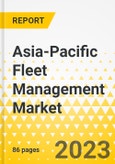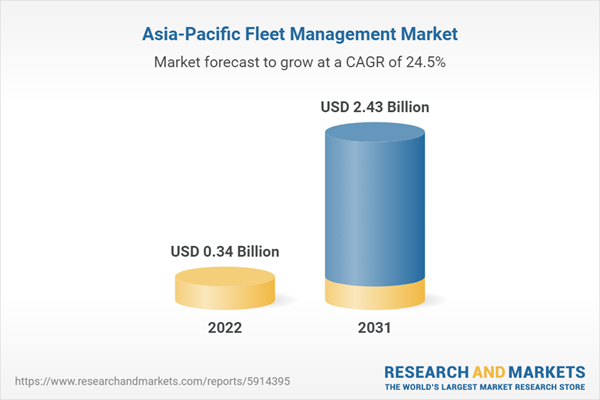10% Free customization
The Asia-Pacific fleet management market is projected to reach $2.43 billion by 2031 from $0.34 billion in 2022, growing at a CAGR of 24.45% during the forecast period 2022-2031. Technological advancements are driving an accelerated growth in commercial vehicle fleet management tools over the predicted period. It is projected that significant market development activities will be enhanced by the advent of connected vehicles. This report comes with 10% free customization, enabling you to add data that meets your specific business needs.
The fleet management market in Asia-Pacific is expanding significantly. Growing awareness of the advantages these systems offer the commercial vehicle sector is driving the growth of the fleet management market. Furthermore, the adoption of new technologies by the industrial revolution has led to a growth in fleet management in the APAC market.
Market Introduction
The APAC fleet management industry is evolving significantly due to technological advancements in commercial vehicle management technologies. Throughout the course of the forecast period, these tools are anticipated to grow fast, and the widespread usage of linked cars is anticipated to greatly boost crucial market development efforts. Due to fleet firms' increasing awareness of the many benefits offered by state-of-the-art management systems, the APAC fleet management industry is now expanding. This greater awareness is one of the primary factors propelling the market's growth, which is also being helped by the ongoing industrial revolution and the APAC commercial vehicle industry's growing use of cutting-edge technologies.Market Segmentation:
Segmentation 1: by Application Type
- Real Time Location Monitoring
- Fuel Management
- Maintenance Management
- Driver Management
- Weight/Volume Tracking
- Accounting and Insurance
Segmentation 2: by Vehicle Type
- Light Commercial Vehicles
- Heavy Commercial Vehicles
Segmentation 3: by Component
- Hardware
- Software
- Service
Segmentation 4: by Deployment
- On-Premises
- Cloud
Segmentation 5: by Country
- Japan
- South Korea
- India
- Rest-of-Asia-Pacific and Japan"
How can this report add value to an organization?
Product/Innovation Strategy: The product segment helps the reader understand the different types of fleet management products available by Component (Hardware, Software, and Service), by Deployment (On-Premises and Cloud), by Application Type (Real Time Location Monitoring, Fuel Management, Maintenance Management, Driver Management, Weight/Volume Tracking, and Accounting and Insurance), by Commercial Vehicle Type (Light Commercial Vehicles and Heavy Commercial Vehicles). Increasing demand worldwide is pushing the sales of fleet management systems. Therefore, the fleet management business is a low-investment and high-revenue generating model.Growth/Marketing Strategy: The APAC Fleet Management Market is exponentially growing, with enormous opportunities for the market players. Some strategies covered in this segment are product launches, partnerships and collaborations, business expansions, and investments. The companies' preferred strategy has been product launches, partnerships, and collaborations to strengthen their positions in the APAC fleet management market.
Competitive Strategy: Key players in the APAC fleet management market analyzed and profiled in the study involve fleet management-based product manufacturers and start-ups. Moreover, a detailed competitive benchmarking of the players operating in the APAC fleet management market has been done to help the reader understand how players stack against each other, presenting a clear market landscape. Additionally, comprehensive competitive strategies such as partnerships, agreements, and collaborations will aid the reader in understanding the untapped revenue pockets in the market.
Key Market Players and Competition Synopsis
The companies that are profiled have been selected based on inputs gathered from primary experts and analysing company coverage, product portfolio, and market penetration.Some of the prominent names established in this market are:
- Embitel
- Queclink Wireless Solutions Co., Ltd.
- Fleetx
- Wonder Wagen
This product will be delivered within 3-5 business days.
Table of Contents
1 Markets
2 Region
3 Markets - Competitive Benchmarking & Company Profiles
4 Research Methodology
List of Figures
List of Tables
Executive Summary
The Asia-Pacific fleet management market (excluding China) is estimated to reach $2.43 billion by 2031, reveals the premium market intelligence study. The study also highlights that the market is set to witness a CAGR of 24.45% during the forecast period 2022-2031.The Asia-Pacific and Japan fleet management market is expected to grow because of the growing commercial vehicle sales in the region, which includes meeting the needs of Japan, South Korea, India, Indonesia, and others, as well as the rising adoption of connected vehicles brought on by changing consumer preferences in emerging markets, rising disposable income, and affordable price points offered by OEMs. The growing population and rapid adoption of fleet management solutions in the region are expected to propel the market in the forecast period 2022-2031.
USPs of report
- Analysis of business drivers and challenges of the Asia-Pacific Fleet Management Market
- Detailed analysis of Fleet Management Market for Japan, South Korea and India
- Segmentation by component, deployment, application type, and vehicle type provided in the report
Analyst’s Perspective on Fleet Management Market
The Principal Analyst states, 'Due to the growing strategic significance of shifting mobility, there is an increase in demand for fleet management on a global scale. As a result, it is anticipated that the worldwide fleet management market will expand considerably throughout the forecast period. It is crucial for fleet businesses wishing to expand their enterprises to adopt fleet management. Its benefits include enhancing client happiness, boosting productivity, reducing gasoline expenses, and offering real-time visibility. The e-commerce, insurance, construction, and mining industries' rising need for commercial vehicles is anticipated to fuel the market for fleet management. Additionally, the industry is expanding faster because of the utilization of artificial intelligence (AI) solutions in fleet management software and hardware.'Some of the prominent names established in this market are:
- Embitel
- Queclink Wireless Solutions Co., Ltd.
- Fleetx
- Wonder Wagen
Key Questions Answered in the Report
- What are the major market drivers, challenges, and opportunities in the Asia-Pacific fleet management market?
- What are the key development strategies deployed by the key players to sustain in the market, and what are some of the initiatives taken by new entrants within this ecosystem?
- What are the views of key industry participants within the fleet management companies operating in the space with respect to the latest trends and developments pertinent to fleet management?
Companies Mentioned
- Embitel
- Queclink Wireless Solutions Co., Ltd.
- Fleetx
- Wonder Wagen
Table Information
| Report Attribute | Details |
|---|---|
| No. of Pages | 86 |
| Published | December 2023 |
| Forecast Period | 2022 - 2031 |
| Estimated Market Value ( USD | $ 0.34 Billion |
| Forecasted Market Value ( USD | $ 2.43 Billion |
| Compound Annual Growth Rate | 24.4% |
| Regions Covered | Asia Pacific |
| No. of Companies Mentioned | 4 |









